सेप . 30, 2024 13:33 Back to list
Comparison of Gate Valves and Globe Valves in Pipeline Systems
Understanding Gate Valves and Globe Valves A Comprehensive Overview
In the realm of fluid control systems, valves play a crucial role in managing the flow of liquids and gases. Among the various types of valves, gate valves and globe valves are two of the most commonly used. Each type has its distinct features, advantages, and applications, making them suitable for different scenarios in various industries.
Gate Valves Overview and Application
Gate valves are primarily designed for fully open or fully closed operations. This type of valve consists of a gate that moves up and down to control fluid flow. When the gate is in the raised position, the flow is unrestricted, allowing for smooth passage of fluid. Conversely, when the gate is lowered, the flow is entirely blocked. This on-off control makes gate valves highly effective in applications where quick isolation of the fluid is necessary.
The most notable feature of gate valves is their low resistance to flow when fully open, which means they can efficiently allow high flow rates with minimal pressure drop. This characteristic makes gate valves particularly suitable for pipelines carrying water, oil, and gas in various industrial sectors, including power plants, water treatment facilities, and oil and gas production.
However, gate valves are not recommended for throttling purposes, as partially opening the valve can lead to turbulence and erosion of the gate. Additionally, they take longer to operate, and in some cases, a complete rotation of the handle might be necessary to fully open or close the valve.
Globe Valves Overview and Application
gate valve globe valve

In contrast to gate valves, globe valves are designed for throttling or regulating the flow of fluid. The internal structure of a globe valve consists of a movable disk or plug that can be adjusted to control the flow passage through a seat. This design allows for precise control of fluid flow, making globe valves ideal for applications where flow regulation is paramount.
One of the significant advantages of globe valves is their ability to maintain a relatively consistent flow rate, even when subjected to varying pressure conditions. This is particularly valuable in applications such as chemical processing, HVAC systems, and water supply networks, where precise flow control is essential.
Globe valves exhibit a higher resistance to flow compared to gate valves when fully open, due to their design. This characteristic can lead to increased pressure drops in the system, making them less suitable for applications that require high flow rates. Additionally, globe valves are generally slower to operate than gate valves, which can be a consideration in systems requiring rapid isolation.
Choosing Between Gate Valves and Globe Valves
When choosing between gate valves and globe valves, it is essential to consider the specific requirements of the application. Gate valves are preferable for applications requiring quick shut-off and minimal flow resistance. They are best suited for situations where a straight-line flow is present, and the control of flow rate is not critical.
On the other hand, globe valves are the preferred choice for systems where flow regulation is necessary. Their ability to finely adjust the flow makes them indispensable in applications such as regulating steam in power plants or controlling the flow of chemicals in processing plants.
In summary, both gate valves and globe valves serve essential functions in fluid control systems, each with unique characteristics suited to different applications. Understanding the specific needs of the process and the properties of each valve type is vital for making informed decisions in valve selection. With appropriate application, these valves ensure efficient operation and reliability in various industrial processes, contributing to the overall safety and efficiency of fluid handling systems.
-
Surface Plate Maintenance Best Practices for LongevityNewsJun.27,2025
-
Historical Evolution of Iron Surface Plates in Industrial MetrologyNewsJun.27,2025
-
Cast Iron Y Strainer Safety StandardsNewsJun.27,2025
-
Blockchain Verification for Gauge Tool Certification IntegrityNewsJun.27,2025
-
Advantages of Triple Offset Butterfly Valve Types in High-Pressure SystemsNewsJun.27,2025
-
Wear Resistance Strategies for Trapezoidal ThreadsNewsJun.26,2025
Related PRODUCTS









